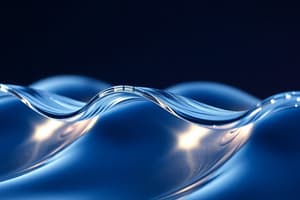Podcast
Questions and Answers
Amplitude refers to how large a waveform gets during its ______.
Amplitude refers to how large a waveform gets during its ______.
cycle
Intensity is another term used synonymously with ______.
Intensity is another term used synonymously with ______.
loudness
Higher frequencies correspond to higher ______, often described as having a brighter tone in musical contexts.
Higher frequencies correspond to higher ______, often described as having a brighter tone in musical contexts.
pitches
When you strike a hammer against a metal surface, small vibrations travel outwards like ripples across ______.
When you strike a hammer against a metal surface, small vibrations travel outwards like ripples across ______.
These vibrations form patterns called ______.
These vibrations form patterns called ______.
______ refers to one complete oscillatory motion of a simple harmonic wave, including both its compression phase and rarefaction phase.
______ refers to one complete oscillatory motion of a simple harmonic wave, including both its compression phase and rarefaction phase.
______ is subjective and relies heavily upon personal perception.
______ is subjective and relies heavily upon personal perception.
An ______ occurs when a sound reflects off surfaces back towards listeners.
An ______ occurs when a sound reflects off surfaces back towards listeners.
Different instruments produce varied timbres and sounds due to differences in their physical structures and materials. Musical instruments broadly fall into three major categories: strings, winds, ______.
Different instruments produce varied timbres and sounds due to differences in their physical structures and materials. Musical instruments broadly fall into three major categories: strings, winds, ______.
Timbre, or tonal color, describes variations among sounds emitted by identical pitched notes played on distinct instruments or voices due to differences in their resonant properties. For instance, a piano note may sound warmer due to its unique combination of harmonics compared to a violin playing the same ______.
Timbre, or tonal color, describes variations among sounds emitted by identical pitched notes played on distinct instruments or voices due to differences in their resonant properties. For instance, a piano note may sound warmer due to its unique combination of harmonics compared to a violin playing the same ______.
Flashcards are hidden until you start studying
Study Notes
Sound: Exploring Amplitude, Intensity, Pitch, Frequency, Waves, and More
Sound is all around us—it's a fundamental part of our daily lives. To understand this ubiquitous phenomenon better, let's delve into some key concepts related to it: amplitude, intensity, pitch, frequency, sound waves, time periods, quality, and different kinds of instruments.
Amplitude and Intensity
Amplitude refers to how large a waveform gets during its cycle. A larger increase in pressure translates to higher amplitude, which also means louder sounds when we talk about music or other audible phenomena. Intensity is another term used synonymously with loudness; it refers to the amount of energy associated with a sound. In essence, the more intense (louder) sound has a larger amplitude.
Pitch and Frequency
Pitches differ from each other based upon their frequencies. Frequencies determine how fast a waveform moves through space over time. Higher frequencies correspond to higher pitches, often described as having a brighter tone in musical contexts. Conversely, lower frequencies result in lower pitches, which can feel deep or mellow.
Sound Waves
When you strike a hammer against a metal surface, small vibrations travel outwards like ripples across water. These vibrations form patterns called sound waves. They propagate through various mediums such as air, water, solids, transmitting information about the source creating them.
Time Period
Time period refers to one complete oscillatory motion of a simple harmonic wave, including both its compression phase and rarefaction phase. It gives us a measure of how quickly a sound travels within any given environment. As the speed of sound varies depending on several factors like temperature, humidity, altitude, etc., so do these time periods change.
Quality
Quality is subjective and relies heavily upon personal perception. Timbre, or tonal color, describes variations among sounds emitted by identical pitched notes played on distinct instruments or voices due to differences in their resonant properties. For instance, a piano note may sound warmer due to its unique combination of harmonics compared to a violin playing the same pitch.
Echo
An echo occurs when a sound reflects off surfaces back towards listeners. This happens because sound generally takes longer to travel through reflection instead of directly reaching ears. Often, echoes make listening environments seem spacious and reverberating, though they might create audio distortion or confusion under specific circumstances.
Types of Instruments
Different instruments produce varied timbres and sounds due to differences in their physical structures and materials. Musical instruments broadly fall into three major categories: strings (violins, guitars), winds (flutes, clarinets), percussions (drums, cymbals). By understanding the acoustical principles underlying instrument design, musicians craft beautiful compositions enhancing their overall experience for audiences everywhere.
Studying That Suits You
Use AI to generate personalized quizzes and flashcards to suit your learning preferences.





